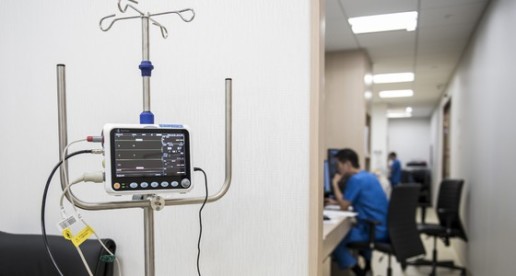A new tool for employee temperature checks ensures safety and security of workers
As employers begin to move employees back into the workplace, they have to be mindful of new legal guidance that has come from the CDC and HIPAA. In regards to new legal guidelines set into place, employers and management teams will now have to check employee temperatures. Read this blog post to learn more.
Temperature checks will be mandated at workplaces once employees return to the office, due to legal guidance from the Centers for Disease Control and Prevention, but privacy concerns could heat up among workers concerned for their security.
“It’s now permissible to take employee temperatures, but if employers store it and keep track of it, there’s no exemption from HIPAA and identity laws,” says Dan Clarke, president of IntraEdge — an Arizona-based tech company.
IntraEdge developed a kiosk that privately takes employees’ temperatures, and only shares the results with the employee, keeping any health information concealed from HR. Instead, managers are simply notified if the kiosk gave their employee permission to enter the office, or not, which completely eliminates the potential for HIPAA violations, Clarke says. The kiosk, called Janus, can also prevent sick employees from entering the office if their temperature is too high.
Clarke spoke in a recent interview about how Janus can help employers protect their workforce, while adhering to privacy laws.
How does Janus help prevent the spread of COVID-19?
If we want to limit exposure to COVID-19, we can’t assign someone in the office to take everyone’s temperature; it’s not efficient and it puts more people at risk. Employers need a digital solution, one that puts them in compliance with HIPAA and privacy laws.
Janus uses an accurate thermal camera to take the temperature of the user. Before using it, employees would need to sign up online and provide information to confirm their identity. After that’s done, they’d go to the kiosk and present their identification through their phone. The kiosk will ask them a few questions about how they’re feeling and the camera will take their temperature. The normal temperature range for each employee is personalized based on the individual’s age and medical history. Many people don’t realize our normal temperature increases as we age. If an employee reads at an unhealthy temperature, they’re not allowed inside the office.
How does this help employers stay compliant with HIPAA and other privacy laws?
Employers don’t have access to their worker’s medical history, or the temperatures read by Janus. The kiosk doesn’t display an employee’s temperature on screen. Instead, the employee will receive a text message telling them their temperature and whether they’re allowed inside the office. Printouts are also available for employees who don’t have smartphones.
Is HR or a manager notified when employees aren’t allowed in the office?
Janus doesn’t share with HR what employees’ temperatures were, only if they were given a “yes” or “no” to enter the office. They can receive a text message whenever an employee is given a “no.” This helps employers stay compliant with HIPAA and privacy laws because they never see the full results, and they’re not stored. But it also helps them keep track of their workforce.
It can also be programmed to notify a security officer that someone didn’t pass the temperature check to ensure compliance. We can also program the kiosk to distribute security badges only to employees who pass the temperature check.
Before coronavirus, employees sometimes came to work sick out of fear their colleagues/managers would question their dedication to their job. Do you think this product will help change that after the crisis is over?
I think the crisis is changing the perception of remote work enough that people will be comfortable saying they’re going to work from home when they don’t feel well. Janus can definitely help enforce it, if the employer chooses, but we wanted to ensure it was useful for employers after the crisis is over. It can also be used to clock employees in and out for work and as office security.
SOURCE: Webster, K. (08 June 2020) "A new tool for employee temperature checks ensures safety and security of workers" (Web Blog Post). Retrieved from https://www.employeebenefitadviser.com/news/a-new-tool-for-employee-temperature-checks-ensures-safety-and-security-of-workers
Working on Wellness: 5 Tips to Help You Prioritize Your Health
When it comes to personal wellness, it doesn't have to be one or the other when choosing health versus work. Read this blog post for five tips on prioritizing personal health and wellness.
Wellness is such a buzzword these days. It seems like everyone is talking about it, and with good reason. Taking care of yourself needs to be a top priority in your life, but that doesn’t mean it's easy. I know that you may feel stressed and overwhelmed with work, family, friends, or other commitments, but at the end of the day, your health should be your most prized commodity. Most people understand the importance of caring for their health, but cite numerous reasons why they just don’t have the time – namely, work. However, it doesn’t have to be one or the other. You can prioritize your well-being and succeed in the office. In fact, my theory is that an individual's personal wellness must be a top priority in order to achieve one's major corporate goals. Not only do I teach this method, but I live it too. Every. Single. Day.
Here are my 5 tips that will help you prioritize your health while thriving in the corporate world.
Find Your Passion
Deciding that you are going to start focusing on wellness is usually not difficult. However, when you are dreading the time you have set aside to go to the gym, that’s when it gets hard. It’s challenging to motivate yourself to do an activity that you despise doing, and it's even harder to keep it up. This is why it is important to find a task that you enjoy doing within the realm of wellness possibilities. Do you like lifting weights or doing aerobic exercises? Maybe swimming, yoga, or hiking is a better fit for you. There are a multitude of possibilities and something for everyone.
Personally, I’m a runner. I participate in ongoing marathons and IRONMAN 70.3 competitions across the globe. Over the next few months, I will embark on several major races. In September, I will be running a Marathon in Capetown, South Africa. The following month, I am going back for my second year of running 55 Miles through the Serengeti in Africa. To keep the momentum going, in November, I will be running in the TCS New York City Marathon. And then in December, I will be completing an IRONMAN 70.3 Cartagena in Colombia. I did not always compete in these types of races, but I worked up to it through rigorous training sessions. Embracing the open terrain while enjoying some time alone with my thoughts as I run is incredible.
Be Mindful of Your Time
The best advice I can give to those who worry that they don’t have enough time to exercise is to be aware of how you are using your time. Are you using your time efficiently to the fullest potential? Is there anything you can cut or shorten the time you devote to? Get creative. For example, I actually develop many of my business strategies while working out. I am able to let my mind ruminate about work while my body focuses on my wellness. Make time to move. Even if it’s just a little bit every day. Try taking a ten-minute break and going on a walk. Afterward, you’ll feel great and will probably be more productive too. The email can wait; your health cannot.
Follow a Routine
Consciously making the effort to prioritize your wellness isn’t always easy. This is why it is important to follow your routine. Stopping for even a few days makes it hard to get back into it again, and restarting again after a break is always the hardest part. On the other hand, sticking to a routine helps working out feel natural. It becomes a part of your day, an activity that happens somewhere in between waking up in the morning and falling asleep at night. Schedule your fitness into your calendar. If it’s on the calendar, it is real – just like that phone call or meeting you have scheduled after your workout. Setting aside time for your health is like making a promise to yourself to care about your well-being. Honor that promise.
Transfer Your Skills
It’s important to remember that working out is not just good for your body. Exercise also helps develop valuable skills that you can transfer to the workplace. I have completed many races this year, all of which help me to stay focused in my personal life and in the office. Following a schedule and setting goals when training and competing fosters an organized and centered mind when I am at work. I can focus on what I want to execute and achieve. The cadence of training is very similar to the way that I operate in the corporate landscape. Similarly, I attribute many of my most prized leadership qualities – including motivation, perseverance, and a stellar ability to navigate the daily struggle of balance – to an active and healthy lifestyle that is the impetus for day-to-day accomplishment. I first learned how to motivate myself to prioritize my well-being and how to persevere when training becomes a challenge. I worked to find a balance that fits my lifestyle. Then I was able to transfer those skills that I learned to helping others. After all, if you cannot take care of yourself, you cannot take care of your team.
Reward Yourself
Choose a fitness goal and obtain it, whether it's running a 5K or something completely different. Every time you train, you'll become stronger. Then, reward yourself when you make progress, whether it’s with a new outfit, new running shoes, or a pedicure that you have been dying to have. You worked hard for a goal and accomplished it, so treat yourself! Likewise, don’t forget the little victories. Be proud of yourself for training each day and be content with what you achieved. You are setting yourself up to be a happier and healthier you—and that is no small thing. This translates to the business side of things as well, the sense of completion.
Prioritizing your health may seem like something that is out of reach for you, simply because it just doesn’t fit into your schedule. But that’s not necessarily the case. If you have the right mindset going in and make a conscious effort, you can focus on both your wellness and corporate life. And you'll be thankful you did!
SOURCE: Vetere, R. (Accessed 1 November 2019) "Working on Wellness: 5 Tips to Help You Prioritize Your Health" (Web Blog Post). Retrieved from https://www.corporatewellnessmagazine.com/article/five-tips-to-prioritize-health
Employers look to virtual services to curb rising health costs
Employers are looking for ways to stem the rising costs of healthcare and find ways to better engage employees. According to the National Business Group on Health, 64 percent of employers believe virtual care will play a significant role in healthcare delivery. Read this blog post to learn more about virtual services.
WASHINGTON — With the continued cost of healthcare benefits expected to increase by another 5%, topping $15,000 per employee, employers are looking for ways to stem the increase and better engage employees in holistic well-being.
One of those ways is through virtual care. The number of employers who believe virtual care will play a significant role in how healthcare is delivered in the future continues to grow, up to 64% going into 2020 from 52% in 2019, according to the National Business Group on Health’s annual healthcare strategy survey.
“Virtual care solutions bring healthcare to the consumer rather than the consumer to healthcare,” Brian Marcotte, president and CEO of NBGH said at a press briefing Tuesday. “They continue to gain momentum as employers seek different ways to deliver cost-effective, quality healthcare while improving access and the consumer experience. Of particular note is the growing interest among employers to offer virtual care for mental health as well as musculoskeletal conditions.”
The majority of respondents (51%) will offer more virtual care programs next year, according to the survey. Nearly all employers will offer telehealth for minor, acute services while 82% will offer virtual mental health services — a figure that’s expected to grow to 95% by 2022.
Virtual care for musculoskeletal management shows the greatest potential for growth, the study noted. While 23% of employers will offer musculoskeletal management virtual services next year, another 38% are considering it by 2022. Physical therapy is the best way to address musculoskeletal conditions and help avoid surgery, but it can be inconvenient and costly, said Ellen Kelsay, chief strategy officer at NBGH.
“Where we’ve seen a lot of development in areas of virtual solutions is to provide remote physical therapy treatments,” she said. “Employees can access treatment through their virtual app wherever it’s convenient for them.”
Regardless, employee utilization of virtual services still remains low. For example, while roughly 70% of large companies provide telemedicine coverage, only 3% of employees use it, according to prior NBGH data.
But many resources are out of sight and out of mind, Kelsay said. However, employers are focusing on offering high-touch concierge services to help workers better navigate the healthcare system.
Employers are reaching a point of saturation with the number of solutions that are available, but from the employee’s perspective, they just don’t know where to start, she added. “These concierge and navigator services really help point employees in the direction to the solution at the point in time they need it.”
In addition, the use of predictive analytics and claims data is also an opportunity to help employers get the right programs in front of employees in the moment, Marcotte added.
“Some of these engagement platforms are getting at personal messaging and predictive analytics. It’s not where we want it to be yet, but as that continues to get better, I think you’ll see utilization go up,” he said.
Digital health revolution: What we’ve learned so far
Digital health devices provide personalized feedback to users, helping improve their health. Continue reading this blog post to learn more about the evolving digital health revolution.
The promise of the digital health revolution is tantalizing: a multitude of connected devices providing personalized feedback to help people improve their health. Yet, some recent studies have called into question the effectiveness of these resources.
While still evolving, many compelling use-cases are starting to emerge for digital health, including a set of best practices that can help guide the maturation of this emerging field. In the near future, many people may gain access to individual health records, a modern medical record that curates information from multiple sources, including electronic health records, pharmacies and medical claims, to help support physicians in care delivery through data sharing and evidence-based guidelines.

As these advances become a reality, here are several digital health strategies employers, employees and healthcare innovators should consider.
Micro-behavior change.
Part of the power of digital health is the ability to provide people with actionable information about their health status and behavior patterns. As part of that, some of the most successful digital health programs are demonstrating an ability to encourage daily “micro-behavior change” that, over time, may contribute to improved health outcomes and lower costs. For instance, wearable device walking programs can remind people to move consistently throughout the day, while offering objective metrics showcasing actual activity patterns and, ideally, reinforcing positive habits to support sustained change. Technology that encourages seemingly small healthy habits — each day — can eventually translate to meaningful improvements.
Clinical interventions.
Big data is a buzz word often associated with digital health, but the use of analytics and technology is only meaningful as part of a holistic approach to care. Through programs that incorporate clinical intervention and support by care providers, the true value of digital health can be unlocked to help make meaningful differences in people’s well-being. For instance, new programs are featuring connected asthma inhalers that use wirelessly enabled sensors to track adherence rates, including frequency and dosage, and relay that information to healthcare professionals. Armed with this tangible data, care providers can counsel patients more effectively on following recommended treatments. Rather than simply giving consumers the latest technologies and sending them along, these innovations can be most effective when integrated with a holistic care plan.
Real-time information.
One key advantage of digital resources, such as apps or websites, is the ability to provide real-time information, both to consumers and healthcare professionals. This can help improve how physicians treat people, enabling for more customized recommendations based on personal health histories and a patient’s specific health plan. For instance, new apps are enabling physicians to know which medications are covered by a person’s health plan and recommend lower-cost alternatives (if available) before the patient actually leaves the office. The ability to access real-time information — and act on it — can be crucial in the effort to use technology to empower healthcare providers and patients.
Financial incentives.
Nearly everyone wants to be healthy, but sometimes people need a nudge to take that first step toward wellness. To help drive that engagement, the use of financial incentives is becoming more widespread by employers and health plans, with targeted and structured rewards proving most effective. From using mobile apps and comparison shopping for healthcare services to encouraging expectant women to use a website to follow recommended prenatal and post-partum appointments, financial incentives can range from nominal amounts (such as gift cards) to hundreds of dollars per year. Coupling digital health resources with financial rewards can be an important step in getting — and keeping — people engaged.
The digital health market will continue to grow, with some studies estimating that the industry will exceed $379 billion by 2024. To make the most of these resources, healthcare innovators will be well served to take note of these initial concepts.
SOURCE: Madsen, R. (14 March 2019) "Digital health revolution: What we’ve learned so far" (Web Blog Post). Retrieved from https://www.benefitnews.com/opinion/digital-health-revolution-what-weve-learned-so-far?brief=00000152-14a5-d1cc-a5fa-7cff48fe0001
Poor employee health costs employers half trillion dollars a year
According to a recent report from the Integrated Benefits Institute, poor employee health costs employers half a trillion dollars each year and almost 1.4 billion in missed work days. Read on to learn more.
Poor employee health is costing employers in a big way — to the tune of half a trillion dollars and nearly 1.4 billion days of missed work each year.
That’s according to a new report from the Integrated Benefits Institute, which finds that employees miss around 893 million days a year from illness and chronic conditions, and another 527 million days because of impaired performance due to those illnesses. Those days add up to $530 billion in lost productivity.
“To put this in further context, the cost of poor health to employers is greater than the combined revenues of Apple, Amazon, Microsoft, Netflix, eBay and Adobe,” says Thomas Parry, president of Integrated Benefits Institute, an independent nonprofit that serves more than 1,250 employers including Amazon, Kroger, McDonald’s and Walmart.

The $530 billion price tag is on top of what employers already spend on healthcare benefits. Employers pay $880 billion in healthcare benefits for their employees and dependents, which means that poor health costs amount to “60 cents for every dollar employers spend on healthcare benefits,” according to the study.
“There’s not a CEO or CFO that can placidly accept their business expending the equivalent of almost two-thirds of their healthcare dollars on lost productivity,” Perry says. “Illness costs this country hundreds of billions of dollars, and we can no longer afford to ignore the health of our workforce.”
Employers invest in healthcare benefits to maintain a productive workforce. But this new study suggests that more needs to be done to keep employees healthy, or strategies need to be put in place to lower spending. Or both.
“It’s critical that employers understand how strategies for managing healthcare spend — such as cost- shifting to employees or ensuring better access and more cost-effective care — can impact the kinds of conditions that drive illness-related lost productivity,” says Brian Gifford, director of research and analytics at IBI.
The study broke down the estimated costs of poor health into several categories:
Wage and benefits (incidental absence due to illness, workers’ compensation and federal family and medical leave): $178 billion.
Impaired performance (attributed to chronic health conditions): $198 billion.
Medical and pharmacy (workers’ compensation, employee group health medical treatments, employee group health pharmacy treatments): $48 billion.
Workers’ compensation other costs (absence due to illness, reduced performance): $25 billion.
Opportunity costs of absence (missed revenues, costs of hiring substitutes, overtime): $82 billion.
For its study, IBI used 2017 data from the U.S. Bureau of Labor Statistics as well as its own benchmarking data from 66,000 U.S. employers.
SOURCE: Paget, S. (20 November 2018) "Poor employee health costs employers half trillion dollars a year" (Web Blog Post). Retrieved from https://www.benefitnews.com/news/poor-employee-health-costs-employers-half-trillion-dollars-a-year?brief=00000152-14a7-d1cc-a5fa-7cffccf00000
HR’s recurring headache: Convincing employees to get a flu shot
According to The National Institute for Occupational Safety and Health, the flu cost U.S. companies billions of dollars in medical fees and lost earnings. Read this blog post to learn how HR departments are convincing their employees to get a flu shot.
Elizabeth Frenzel and her team are the Ford assembly line of flu shots: They can administer about 1,800 flu shots in four hours.
Frenzel is the director of employee health and wellbeing at the University of Texas MD Anderson Cancer Center, and with 20,000 employees, she is no stranger to spearheading large flu shot programs. The center where Frenzel administers flu shots has roughly a 96% employee vaccination rate. Back in 2006, only about 56% of employees got their shots.
“When you run these large clinics, safety is critically important,” she says.
Problems like Frenzel’s are not unique. Every fall, HR departments send mass emails encouraging employees to get vaccinated. The flu affects workforces across the country, costing U.S. companies billions of dollars in medical fees and lost earnings, according toThe National Institute for Occupational Safety and Health. It is not only a cause of absenteeism but a sick employee can put their coworkers at risk. Last year the flu killed roughly 80,000 people, according to the Centers for Disease Control.
Even if an employer offers a flu shot benefit, the push to get employees to sign up for the vaccine can be a two-month slough, with reminder emails going unanswered. Moreover, companies often contend with misconceptions about the shot, such as the popular fallacy that shots will make you sick, running out of the vaccine, and sometimes just plain employee laziness.
In Frenzel’s case, increasing the number of employees who got flu shots weren’t just a good idea, but it was needed to protect the lives of the cancer patients they interact with every day. The most startling fact, she says, was that healthcare workers who interact with patients daily were less likely to get vaccinated.
“So that’s how we started down the path,” she says. “Really targeting these people who had the closest patient contact.”
Frenzel credits the significant increase in employee participation in the flu shot program to several factors. They made the program mandatory — a common move in the healthcare industry — but Frenzel says their improvement also was related to flu shot education. The center made it a priority to explain to staff members exactly why they should get vaccinated. Frenzel made it more convenient, offering the vaccine at different hours of the day, so all employees could fit it into their schedule. They also made it fun, offering stickers for employees to put on their badge once they got a shot. Every year, she says, they pick a new color.
Employers outside of the medical industry are focused on improving their flu shot programs, including Edward Yost, manager of employee relations and development at the Society for Human Resource Management, who helped organize a health fair and flu shot program for 380 employees.
Yost says onsite flu shot programs are more effective than vouchers that allow employees to get vaccinated at a primary care doctor or pharmacy. The more convenient you make the program, he says, the more likely employees will use it.
“There’s no guarantee that those vouchers are going to be used,” he says. “Most people aren’t running out to a Walgreens or a CVS saying, please stab me in the arm.”
Besides the convenience, employees are more likely to sign up for a shot when they see co-workers getting vaccinated, Yost says. If a company decides to offer an onsite program, planning ahead is key. Sometimes employees will not sign up in advance for the vaccine but then decide they want to get one once the vendor arrives onsite. Yost recommends companies order extra vaccines.
“Make sure that you’re building in the expectation that there's going to be at least a handful of folks who are more or less what you call walk-ins in that circumstance,” he says.
Incentivizing employees to get the flu shot is also important, Yost says. Some firms will offer a gym membership or discounted medical premiums if they attend regular checkups and get a biometric screening in addition to a flu shot. He recommends explaining to employees how a vaccine can help reduce the number of sick days they may use.
“Employees need to see that there’s something in it for them,” Yost says. “And quite honestly, being sick is a miserable thing to experience.”
Affiliated Physicians is one of the vendors that can come in and administer flu shots in the office. The company has provided various employers with vaccines for more than 30 years, including SourceMedia, the parent company of Employee Benefit News andEmployee Benefit Adviser. In the past 15 years, Ari Cukier, chief operating officer of the company, says there’s been an increase in the amount of smaller companies signing up for onsite vaccines. HR executives should be aware of the number of employees signing up for vaccinations when scheduling an onsite visit.
“We can’t go onsite for five shots, but 20-25 shots and up, we’ll go,” Cukier says.
Cukier agrees communication between human resources departments and employees is crucial in getting people to sign up for shots. Over the years, he’s noticed that more people tend to sign up for shots based on the severity of the previous flu season.
“Last year, as bad as it was, we have seen a higher participation this year,” he says.
Brett Perkison, assistant professor of occupational medicine at the University of Texas School of Public Health in Houston, says providing a good flu shot program starts from the top down. The company executives, including the CEO and HR executives, should set an example by getting and promoting the shots themselves, he says.
It’s also important to listen to employee concerns. Before implementing a program, if workers are taking issue with the shot, it’s best to hold focus groups to alleviate any worries before the shots are even being administered, he says.
Some employees may even believe misconceptions like the flu shot will make one sick or lead to long-term illnesses, he says. Others may question the effectiveness of the shot. Having open lines of communication with employees to address these concerns will ensure that more will sign up, Perkison says.
Regardless of the type of flu shot program, the most important part is preventing illness, SHRM’s Yost says. While missing work and losing money are important consequences of a flu outbreak, having long-term health issues is even more serious, he says. Plus, no one likes being sick.
“Who’s going to argue about that?” he says.
This article originally appeared in Employee Benefit News.
SOURCE: Hroncich, C (24 October 2018) "HR’s recurring headache: Convincing employees to get a flu shot" (Web Blog Post). Retrieved from https://www.employeebenefitadviser.com/news/hrs-recurring-headache-convincing-employees-to-get-a-flu-shot
7 wellness program ideas you may want to steal
Need more energy and excitement in your office? Keep your employees healthy and motivated with these fun wellness program ideas.
Building your own workplace wellness program takes work–and time–but it’s worth it.
“It’s an investment we need to make,” Jennifer Bartlett, HR director at Griffin Communication, told a group of benefits managers during a session at the Human Resource Executive Health and Benefits Leadership Conference. “We want [employees] to be healthy and happy, and if they’re healthy and happy they’ll be more productive.”
Bartlett shared her experiences building, and (continually) tweaking, a wellness program at her company–a multimedia company running TV outlets across Oklahoma –over the last seven years. “If there was a contest or challenge we’ve done it,” she said, noting there have been some failed ventures.
“We got into wellness because we wanted to reduce health costs, but that’s not why we do it today,” she said. “We do it today because employees like it and it increases morale and engagement.”
Though Griffin Communication's wellness program is extensive and covers more than this list, here are some components of it that's working out well that your company might want to steal:
- Fitbit challenge.Yes, fit bits can make a difference, Bartlett said. The way she implemented a program was to have a handful of goals and different levels as not everyone is at the same pace-some might walk 20,000 steps in a day, while someone else might strive for 5,000. There are also competition and rewards attached. At Griffin Communications, the company purchased a number of Fitbits, then sold them to its employees for half the cost.
- Race entry.Griffin tries to get its employees moving by being supportive of their fitness goals. If an employee wants to participate in a race-whether walking or running a 5k or even a marathon, it will reimburse them up to $50 one time.
- Wellness pantry.This idea, Bartlett said, was "more popular than I ever could have imagined." Bartlett stocks up the fridge and pantry in the company's kitchen with healthy food options. Employees then pay whole sale the price of the food, so it's a cheap option for them to instead of hitting the vending machine. "Employees can pay 25 cents for a bottled water or $1.50 for a soda from the machine."
- Gym membership."We don't have an onsite workout facility, but we offer 50 percent reimbursement of (employees') gym membership cost up to a max of 200 per year," she said. The company also reimburses employees for fitness classes, such as yoga.
- Biggest Loser contest.Though this contest isn't always popular among companies, a Biggest Loser-type competition- in which employees compete to lose the most weight-worked out well at Griffin. Plus, Bartlett said, "this doesn't cost us anything because the employee buys in $10 to do it." She also insisted the company is sensitive to employees. For example, they only share percentages of weight loss instead of sharing how much each worker weights.
- "Project Zero" contest.This is a program pretty much everyone can use: Its aim is to avoid gaining the dreaded holiday wights. The contest runs from early to mid- November through the first of the year. "Participants will weigh in the first and last day of the contest," Bartlett said. "The goal is to not gain weight during the holidays-we're not trying to get people to lose weight but we're just to not get them to not eat that third piece of pie."
- Corporate challenges.Nothing both builds camaraderie and encourages fitness like a team sports or company field day. Bartlett said that employees have basically taken this idea and run with it themselves- coming up with fun ideas throughout the year.
SOURCE:
Mayer K (14 June 2018) "7 wellness program ideas you may want to steal" [Web Blog Post]. Retrieved from https://www.benefitspro.com/2015/10/10/7-wellness-program-ideas-you-may-want-to-steal/
Employers Spend $742 per Employee for Wellness Program Incentives
How much money are you spending on your employees and their wellness program? Check out this great article by Brookie Madison from Benefits News on how employers are encouraging more of their employees to sign-up for company sponser wellness programs.
Wellness programs are popular with employers but employees continue to need motivation to participate. Seventy percent of employers are investing in wellness programs, while 73% of employees say they are interested in wellness programs, but 64% of employees undervalue the financial incentives to join the wellness programs, according to UnitedHealthcare’s Consumer Sentiment Survey entitled “Wellness Check Up.”
Only 7% of employees understand the four basic terms of health care —premium, deductible, copayment and coinsurance — which is why UHC didn’t find it surprising that workers underestimate their financial incentives in wellness programs, says Rebecca Madsen, chief consumer officer for UnitedHealthcare.
Despite this disconnect between what employers are offering to help ensure their employees’ health and what employees are willing to do to maintain a healthy well-being, the most appealing incentives to employees for wellness programs are health insurance premium reductions (77%), grocery vouchers (64%) and health savings accounts (62%).
Employees find the financial incentives of the wellness programs appealing, yet only 24% of employees are willing to give up one to three hours of their time per week to exercise, attend wellness coaching sessions or research healthier recipes to eat.
“Unwilling to engage is part of the problem why a third of the country is obese and another third is overweight. We have a real problem in terms of keeping people healthy and that’s what we want to help address,” says Madsen.
Madsen recommends that employers promote their wellness programs and incentives multiple times throughout the year. Gift cards, reduction of premiums and contributing to health savings accounts are leading ways to reward employees. “Incentives on an ongoing basis get people engaged and motivated to participate for a long period of time,” says Madsen.
Wellness programs also provide a way for employers to adjust their benefit packages to be customized and be more than a ‘one size fits all’ approach. “Look at your insurance claims, work with insurance providers and identify common health challenges. See where you have prevalent healthcare needs and who your high risk populations are to develop programs that target those results,” suggests Madsen.
Wellness programs need endless support from advisers, insurance providers, consultants, consumers, friends, family members and employers in order to encourage employees to live healthy lifestyles, according to UnitedHealthcare.
Madsen suggests that employers have onsite biometric screenings. “Helping people know their numbers will help them understand where they have an opportunity to improve their health, which would make them motivated to engage more,” says Madsen.
New trends of wellness programs incorporate the use of activity trackers. Twenty-five percent of employees use an activity tracker and 62% would like to use one as part of a wellness program.
See the original article Here.
Source:
Madison B. (2017 July 17). Employers spend $742 per employee for wellness program incentives [Web blog post]. Retrieved from address https://www.benefitnews.com/news/employers-spend-742-per-employee-for-wellness-program-incentives?feed=00000152-18a4-d58e-ad5a-99fc032b0000
Eating a Little Bit Healthier Helps You Live Longer
Are your eating habits having a negative effect on your body? Check out this great column by Alice Park from Time for some great tips on how you can tweak your current diet to help improve your quality of life.
No surprise here: people who follow healthy diets tend to lead longer, healthier lives. But most of the studies backing this assertion compared people who ate well to people who didn't. Does changing your own diet over many years make much of a difference?
In a new study published in the New England Journal of Medicine, researchers found that it did. People who added in some wholesome foods over time—even if they didn't necessarily commit to making over their entire way of eating—improved their chances of living longer.
Researchers looked at data from the same group of people over 12 years to see if those who changed their diet for better or for worse—either by eating more healthy foods or more unhealthy foods—lived longer or died earlier than those who didn’t change what they ate.
The study involved more than 73,700 men and women enrolled in two long-term health studies. People were asked to record their typical diet at the start of the study, then to fill out food questionnaires every four years for 12 years after that. The researchers then scored the diets by ranking the healthfulness of food components including vegetables, fruit, whole grains, nuts, red meat, fish and dairy, as well as things like sugar-sweetened beverages. Using the reports, researchers were able to gauge how much of a person’s eating habits changed over time.
People who said they ate more healthy foods over time had a lower risk of dying during the study period. The more healthy foods people added to their diet, the lower their risk. It worked the other way, too. Those who ate more unhealthy foods over time saw their risk of dying during the study go up.
The good news is that adding in any amount of healthy foods may help lower the risk of early death. Improving diet by just 20% was linked to a 8-17% lower risk of premature death. (Eating 20% more of unhealthy foods, in contrast, contributed to a 6-12% increased risk in death.)
Even cleaning up one meal a day seems to help. Swapping out one serving of red or processed meat a day with healthier nuts or legumes was linked to any where from an 8% to 17% drop in the risk of premature death.
See the original article Here.
Source:
Park A. (2017 July 12). Eating a little bit healthier helps you live longer [Web blog post]. Retrieved from address https://time.com/4855506/healthy-diet-live-longer/
Non-drug approaches to pain management prove effective
Helpful insights on pain coping techniques from Industrial Safety & Hygiene News (ISHN)
Data from a review of U.S.-based clinical trials published in Mayo Clinic Proceedings suggest that some of the most popular complementary health approaches — such as yoga, tai chi, and acupuncture — appear to be effective tools for helping to manage common pain conditions. The review was conducted by a group of scientists from the National Center for Complementary and Integrative Health (NCCIH) at the National Institutes of Health.
Millions of Americans suffer from persistent pain that may not be fully relieved by medications. They often turn to complementary health approaches to help, yet primary care providers have lacked a robust evidence base to guide recommendations on complementary approaches as practiced and available in the United States. The new review gives primary care providers — who frequently see patients with chronic pain — tools to inform decision-making on how to help manage that pain.
“For many Americans who suffer from chronic pain, medications may not completely relieve pain and can produce unwanted side effects. As a result, many people may turn to nondrug approaches to help manage their pain,” said Richard L. Nahin, Ph.D., NCCIH’s lead epidemiologist and lead author of the analysis. “Our goal for this study was to provide relevant, high-quality information for primary care providers and for patients who suffer from chronic pain.”
The researchers reviewed 105 U.S.-based randomized controlled trials, from the past 50 years, that were relevant to pain patients in the United States and met inclusion criteria. Although the reporting of safety information was low overall, none of the clinical trials reported significant side effects due to the interventions.
The review focused on U.S.-based trial results on seven approaches used for one or more of five painful conditions — back pain, osteoarthritis, neck pain, fibromyalgia, and severe headaches and migraine — and found promise in the following for safety and effectiveness in treating pain:
- Acupuncture and yoga for back pain
- Acupuncture and tai chi for osteoarthritis of the knee
- Massage therapy for neck pain with adequate doses and for short-term benefit
- Relaxation techniques for severe headaches and migraine.
Though the evidence was weaker, the researchers also found that massage therapy, spinal manipulation, and osteopathic manipulation may provide some help for back pain, and relaxation approaches and tai chi might help people with fibromyalgia.
“These data can equip providers and patients with the information they need to have informed conversations regarding non-drug approaches for treatment of specific pain conditions,” said David Shurtleff, Ph.D., deputy director of NCCIH. “It’s important that continued research explore how these approaches actually work and whether these findings apply broadly in diverse clinical settings and patient populations.”
Read more about this report at nccih.nih.gov/pain_review.
About the National Center for Complementary and Integrative Health (NCCIH): NCCIH’s mission is to define, through rigorous scientific investigation, the usefulness and safety of complementary and integrative health approaches and their roles in improving health and health care. For additional information, call NCCIH’s Clearinghouse toll free at 1-888-644-6226, or visit the NCCIH Web site at nccih.nih.gov. Follow us on Twitter (link is external),Facebook (link is external), and YouTube.
About the National Institutes of Health (NIH): NIH, the nation's medical research agency, includes 27 Institutes and Centers and is a component of the U.S. Department of Health and Human Services. NIH is the primary federal agency conducting and supporting basic, clinical, and translational medical research, and is investigating the causes, treatments, and cures for both common and rare diseases. For more information about NIH and its programs, visit www.nih.gov.
See the original article Here.
Reference
Nahin RL, Boineau R, Khalsa PS, Stussman BJ, Weber WJ. (2016 September 7). Evidence-based evaluation of complementary health approaches for pain management in the United States. Mayo Clinic Proceedings. 2016;91(9):1292-1306. Retrieved from address https://www.ishn.com/articles/104834-non-drug-approaches-to-pain-management-prove-effective









